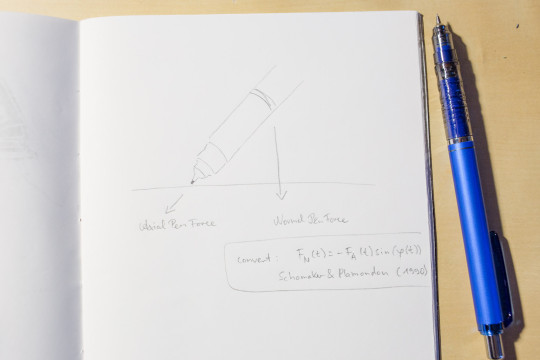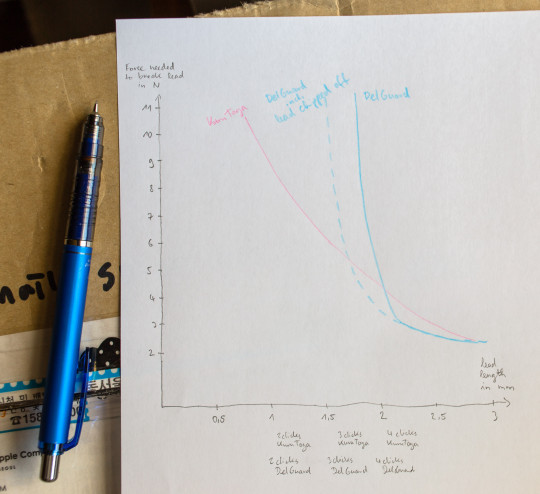Zebra DelGuard
I realise that the blog post about the force needed for the sliding sleeve of different mechanical pencils was not very popular, so please bear with me for a similar blog post, before I get back to more traditional blog posts.
In January this year I bought the Zebra DelGuard mechanical pencil in 0.5mm. You might have come across it on Lexikaliker, where it was mentioned in October 2014. I bought mine from Japan, through Amazon Marketplace where it was sold as the Delgado pencil, instead of DelGuard, based on the Katakana spelling of the pencil’s Japanese name.
I paid £5, but I noticed that it is now available for £4.26, including free delivery.
Two different mechanisms
This mechanical pencil’s ‘specialty’ are two different mechanisms that help prevent the leads from breaking.
If there is too much axial pen force, i.e. pressure is applied to the lead towards the centre of the pen, the lead will retract, i.e. it is cushioned, somehow similar to the Faber-Castell TK_Fine Vario L.
If there is too much normal pen force, i.e. pressure is applied to the side of the lead, a protective guard will extend to protect the lead from breaking. This guard can obviously only extend a certain amount, so it is possible to break an excessively long lead, more about this later.

Not working as advertised?
The packaging states that ‘If you advance lead more than 4 times breakage is possible‘. I wonder whether they either explained it wrong or whether I got a dodgy DelGuard, because using my normal writing angle on my DelGuard the lead will also break if the lead has been advanced 4 times. More on the clicks later. Maybe the text should read ‘If you advance lead 4 or more times’? Maybe other DelGuard users can comment on this.
Comparison with another mechanical pencil
I compared the pressure that will cause the lead to break to another mechanical pencil. I chose the Kuru Toga, previously mentioned here, thinking that both are from Japan, so there is a higher probability of the leads they come with being similar in terms of softness and strength [1]Comparing the breakage point to a pencil with much harder or softer lead would be less exciting.. Both mechanical pencils were tested with the leads they came with using an angle of 45°.

The axis at the bottom shows the lead length in millimetres, with the number of clicks marked as well. You will probably have to enlarge this image to see it well (right click and open in new tab/window). The axis on the left shows the force needed, in Newton, to break the lead.
To put things in context: The highest force needed for moving sliding sleeves was 1 N, but even to break a very long lead you need more than 2 N.
Personally I don’t extend the lead more than 0.5 mm or 1 mm, so I don’t really have problems with lead breakage anyway, but that didn’t prevent me from getting a DelGuard to marvel at the engineering ingenuity that built this pencil.
As you can see, the longer the lead extended on the Kuru Toga (red line) the easier it is to break.
For the DelGuard (blue line) it is virtually impossible to break the lead if it”s extended less than 1.5 mm, because of the guard that will extend. The dotted blue line represents the situation if you count bits of the lead being chipped off as breakage, the solid blue line represents proper breakage.
The warnings that came with the diagram from the Color Eno blog post apply here as well [2]Here’s a copy and paste: I have neither the training, nor experience, nor the equipment to take these measurements properly, so you better take these measurements with a pinch of salt, or even … Continue reading.
Leads and millimetres
One click on the DelGuard will advance the lead by ~0.52 mm, less than what you get with the Kuru Toga, where one click will advance the lead by ~ 0.57 mm and certainly less than what you got with many pencils reviewed at Dave’s Mechanical Pencils. The break safe ‘zone’ for the extended lead is therefore everything between 0 mm and 1.6 mm. I usually don’t extend the lead more than 1 mm, so the lead is quite safe, but other people might use their pencils in different ways.
Video
Please have a look at this little video I made to see the DelGuard in action (Watch in YouTube for higher resolution).
If you like this blog post you might also like the blog post about the Noris colour wear and tear.
You can find a review of the DelGuard at The Pen Addict and at That One Pen.
You can read more about Axial and Normal Pen Force in this paper.
References
| ↑1 | Comparing the breakage point to a pencil with much harder or softer lead would be less exciting. |
|---|---|
| ↑2 | Here’s a copy and paste: I have neither the training, nor experience, nor the equipment to take these measurements properly, so you better take these measurements with a pinch of salt, or even better with a whole lorryload full of salt. |